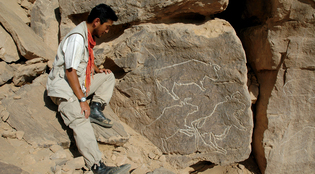 loading
loading
FindingsGlobalism, ca. 13,000 BCEAncient intercontinental connections.  RMAH/BrusselsView full image
The caves of Altamira in northern Spain and Lascaux in southwestern France are famous for their Paleolithic artwork, at least 15,000 years old. Many of those images are of wild cattle and are strikingly similar to those shown here. But these carvings in sandstone are near the village of Qurta, southeast of Cairo—a world away, in Paleolithic terms. Could there be a connection? The first archaeologists to examine some carvings at Qurta, in the early 1960s, decided they could not be Paleolithic. But after a recent re-analysis and use of a new dating technology, Dirk Huyge, of the Royal Museum of Art in Brussels, and an international research team, including Yale Egyptologist John Coleman Darnell, say there’s no doubt. In the December 2011 issue of Antiquity, they show that the Qurta images—at least 185 in all, from birds to hippopotami—are not only contemporaneous with those in Spain and France, but also share their style and groupings. Though artists in western Europe and Upper Egypt “did not share a common physical culture and probably did not trade materials directly,” says Darnell, “it looks like they were trading ideas and artistic styles. Long before there was an economic trade route, there may have been an intellectual one.”
The comment period has expired.
|
|